The roads of Medieval Galicia. Fighting against Carolingian script?
Review/comment of the book “Los caminos medievales de Galicia” by Elisa Ferreira Priegue (Ourense 1988). ISBN 84 505 7318 1.
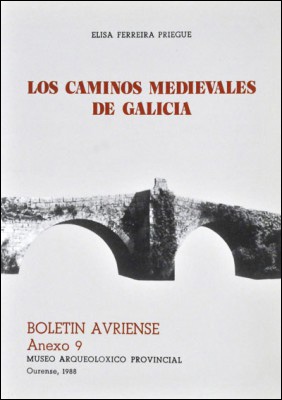
Studying the graphic evolution of Visigothic script, specifically the minuscule variant in transition to Caroline minuscule script, I grabbed this book from the library because I thought it would help me understand how the new writing system slipped in Galician scriptoria, marking the Visigothic script from the mid-eleventh century onwards. I started reading and I could not stop until finishing it!
The author of this book, Elisa Ferreira, is a professor of Medieval History at the University of Santiago de Compostela. The work is excellent and very interesting for reading it as a reference book and even as a literary work. It thoroughly reconstructs all the roads, main and secondary, linking villages, monasteries, and cathedrals of medieval Galicia in such a detail that you can imagine people travelling through them, suffering hardship, carrying goods up and down... I really enjoyed reading it.
In addition to the useful information, I found directly related to my project and which I will discuss below, I learned two interesting things about the Roman roads and their transition to medieval times:
- First, that, in theory, the Roman road had pebbles in the centre and large slabs on both sides while the medieval version, on the other hand, had a central hall. Also, it seems that Galicia repeated hereinafter the Roman type, while the medieval technique was followed in northern Portugal.
- Second, on the abandonment (or use) of the Roman roads in the Middle Ages. According to the thesis of A. Leighton (Transport and communication in Early Medieval Europe, AD 500-1100, Devon 1972), the Roman roads were abandoned by the introduction of the horseshoe on horses. Go riding on roads with pebble was dangerous for the horse and for the rider. However, it seems that this does not apply to Galicia. The Roman roads were not made from scratch but simply improved pre-Roman roads, natural ways, and these roads continued to be used in the Middle Ages linking one village to another (of course, if the Roman settlement was abandoned the road was too). Knowing the landscape of Galicia and having travelled for some of these old roads, I cannot even imagine how it would have been to go for other ways in the Middle Ages! It is true that would not be easy to ride for these cobblestone roads, but believe me when I say that the other options were/are far more dangerous! Galicia has not exactly little rough orography…
Anyway… as I was saying, the motivation that led me to choose this book was my interest in studying how the French graphic influence arrived in Galicia. How Caroline minuscule script was spread across the Kingdom.
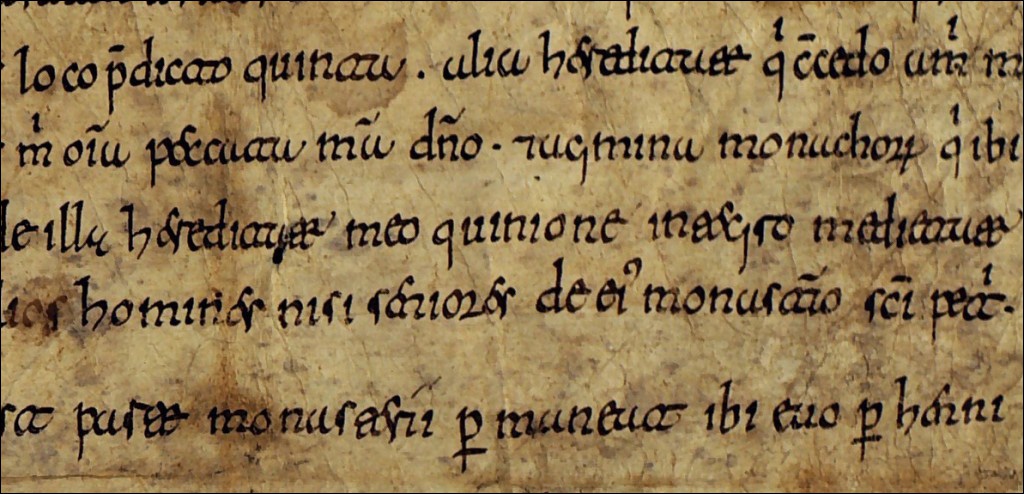 Graphic example. Visigothic minuscule script in transition to Caroline minuscule.
Graphic example. Visigothic minuscule script in transition to Caroline minuscule.
In studying the manuscripts preserved for the diocese of Lugo, I concluded that the influence from Caroline minuscule script was scarce while, in contrast, the muniments preserved from the diocese of Santiago, on which I am working now, show an outstanding Caroline minuscule influence from an earlier date. How could we explain this difference?
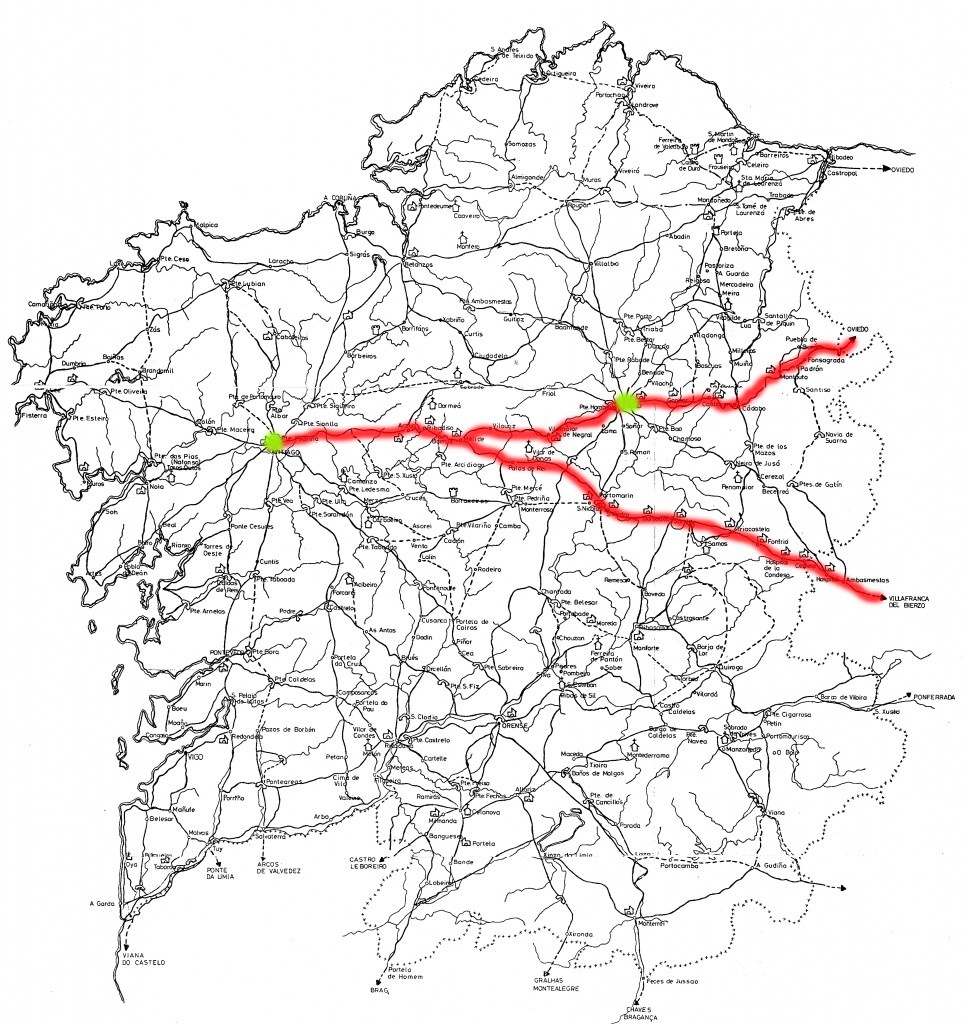 ‘Los caminos de Galicia’. I have highlighted the two ways (the Primitive Road at the top) in red and the sees, Santiago and Lugo, in green.
‘Los caminos de Galicia’. I have highlighted the two ways (the Primitive Road at the top) in red and the sees, Santiago and Lugo, in green.
The medieval terrestrial route linking Europe with Galicia in the Middle Ages was the Camino de Santiago. Through it has to be assumed not only goods from abroad the Kingdom were circulating but also books, scribes and maybe even masters. Displaying the open road routes to Santiago, the two centres studied, Lugo and Santiago received this French influence, theoretically, alike. The so-called ‘Primitive Road’, in use since the mid-ninth century, went through Lugo in its direction to Santiago. While following the ‘French Road’, opened in the tenth century, pilgrims could choose whether to stop in Lugo or go directly to Santiago.
So, if the road went through both centres, why was the Caroline minuscule influence stronger in Santiago than in Lugo? I have two theories:
- The simple one: because being Santiago the final destination, pilgrims, merchants or travellers would remain longer or even settle, so the French/Caroline minuscule influence was, therefore, more important there than in Lugo.
- The naughty (and my favourite): what about if the lucense (from Lugo) see was voluntarily impervious to outside influences? Maybe they knew the Caroline minuscule writing system but wanted to stay devoted to their Visigothic script. Could be? This would also suggest a link between the ‘traditionalism’ for which Lugo is well-known and has seemed always proud and the use of Visigothic script. It makes sense that, when in the late eleventh century the king ‘suggested’ changing the script, the ‘trendy’ diocese and not the older one was the one interested in following the “friendly advice”...
I will keep working on this. So many questions to answer!
by A. Castro
[edited 11/07/2018]
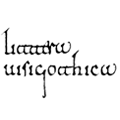
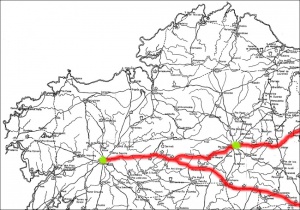
David Mackenzie
French influence is clearly responsible at Santiago, with the appointment of Diego Gelmírez, who was associated with Cluny, and regarded it as his ‘mother house’. He must have had a scriptorium, whose leading lights were the compilers of the Historia Compostellana. This was also the period of influence of French religious orders, principally Benedictines and Cluniacs. The sadly missed Richard A Fletcher is essential reading for this period. It must be remembered also that Santiago was much more important than Lugo; it had the Saint’s remains, after all. All this, I fear is off the top of my head. If you want to discuss it at greater length when I recover from the flu, you can contact me off-list at xelmirez@gmail.com. Good luck. and Happy New Year, David Mackenzie.
Ainoa
David,
I am glad to hear from you, it has been a long time! I hope you are feeling better.
I know that Santiago was more important, I know that Xelmirez was obstinate enough to accomplish that, but what keeps me amazed is how can be followed all the politic stuff through the script, even an ‘a’ can tell us so much! My intention with this post was to talk from an outsider point of view (as I am doing with the next one on graphic influences) but I am Galician after all, maybe I tried to avoid it too much… The first chapter of Richard A Fletcher’s book on Xelmirez is something I know from heart, I always smile when he says that Galicians are ‘friendly and cheerful’. Anyway, my next post will be about Burgundians, the Gregorian reform, Cistercians and so on, so I will be pleased to chat about that with you. But, a warning, I am not on “Xelmirez team”.
All my best, Ainoa.